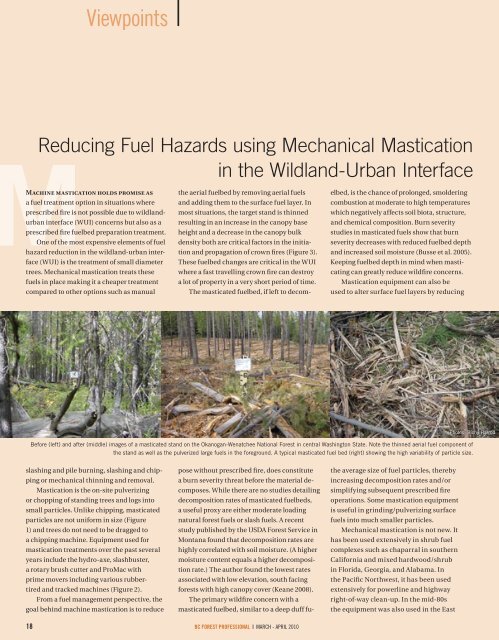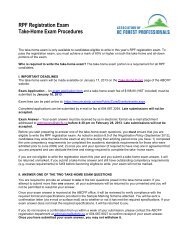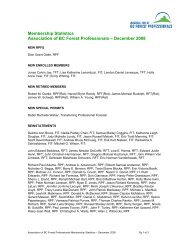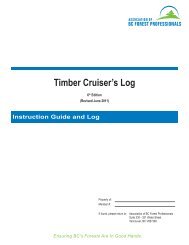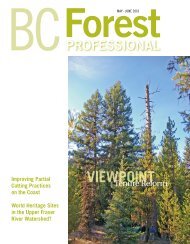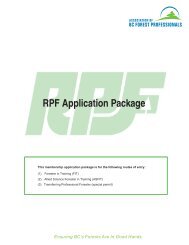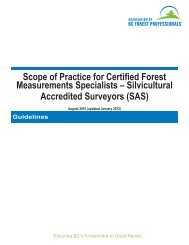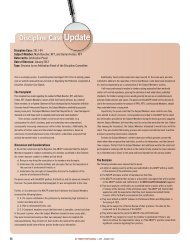VIEWPOINT - Association of BC Forest Professionals
VIEWPOINT - Association of BC Forest Professionals
VIEWPOINT - Association of BC Forest Professionals
Create successful ePaper yourself
Turn your PDF publications into a flip-book with our unique Google optimized e-Paper software.
Viewpoints<br />
Reducing Fuel Hazards using Mechanical Mastication<br />
in the Wildland-Urban Interface<br />
Machine mastication holds promise as<br />
a fuel treatment option in situations where<br />
prescribed fire is not possible due to wildlandurban<br />
interface (WUI) concerns but also as a<br />
prescribed fire fuelbed preparation treatment.<br />
One <strong>of</strong> the most expensive elements <strong>of</strong> fuel<br />
hazard reduction in the wildland-urban interface<br />
(WUI) is the treatment <strong>of</strong> small diameter<br />
trees. Mechanical mastication treats these<br />
fuels in place making it a cheaper treatment<br />
compared to other options such as manual<br />
slashing and pile burning, slashing and chip-<br />
ping or mechanical thinning and removal.<br />
Mastication is the on-site pulverizing<br />
or chopping <strong>of</strong> standing trees and logs into<br />
small particles. Unlike chipping, masticated<br />
particles are not uniform in size (Figure<br />
1) and trees do not need to be dragged to<br />
a chipping machine. Equipment used for<br />
mastication treatments over the past several<br />
years include the hydro-axe, slashbuster,<br />
a rotary brush cutter and ProMac with<br />
prime movers including various rubbertired<br />
and tracked machines (Figure 2).<br />
From a fuel management perspective, the<br />
goal behind machine mastication is to reduce<br />
the aerial fuelbed by removing aerial fuels<br />
and adding them to the surface fuel layer. In<br />
most situations, the target stand is thinned<br />
resulting in an increase in the canopy base<br />
height and a decrease in the canopy bulk<br />
density─both are critical factors in the initiation<br />
and propagation <strong>of</strong> crown fires (Figure 3).<br />
These fuelbed changes are critical in the WUI<br />
where a fast travelling crown fire can destroy<br />
a lot <strong>of</strong> property in a very short period <strong>of</strong> time.<br />
The masticated fuelbed, if left to decom-<br />
pose without prescribed fire, does constitute<br />
a burn severity threat before the material decomposes.<br />
While there are no studies detailing<br />
decomposition rates <strong>of</strong> masticated fuelbeds,<br />
a useful proxy are either moderate loading<br />
natural forest fuels or slash fuels. A recent<br />
study published by the USDA <strong>Forest</strong> Service in<br />
Montana found that decomposition rates are<br />
highly correlated with soil moisture. (A higher<br />
moisture content equals a higher decomposition<br />
rate.) The author found the lowest rates<br />
associated with low elevation, south facing<br />
forests with high canopy cover (Keane 2008).<br />
The primary wildfire concern with a<br />
masticated fuelbed, similar to a deep duff fu-<br />
18 <strong>BC</strong> FOREST PROFESSIONAL | MARCH - ApRil 2010<br />
elbed, is the chance <strong>of</strong> prolonged, smoldering<br />
combustion at moderate to high temperatures<br />
which negatively affects soil biota, structure,<br />
and chemical composition. Burn severity<br />
studies in masticated fuels show that burn<br />
severity decreases with reduced fuelbed depth<br />
and increased soil moisture (Busse et al. 2005).<br />
Keeping fuelbed depth in mind when masticating<br />
can greatly reduce wildfire concerns.<br />
Mastication equipment can also be<br />
used to alter surface fuel layers by reducing<br />
Before (left) and after (middle) images <strong>of</strong> a masticated stand on the Okanogan-Wenatchee National <strong>Forest</strong> in central Washington State. Note the thinned aerial fuel component <strong>of</strong><br />
the stand as well as the pulverized large fuels in the foreground. A typical masticated fuel bed (right) showing the high variability <strong>of</strong> particle size.<br />
the average size <strong>of</strong> fuel particles, thereby<br />
increasing decomposition rates and/or<br />
simplifying subsequent prescribed fire<br />
operations. Some mastication equipment<br />
is useful in grinding/pulverizing surface<br />
fuels into much smaller particles.<br />
Mechanical mastication is not new. It<br />
has been used extensively in shrub fuel<br />
complexes such as chaparral in southern<br />
California and mixed hardwood/shrub<br />
in Florida, Georgia, and Alabama. In<br />
the Pacific Northwest, it has been used<br />
extensively for powerline and highway<br />
right-<strong>of</strong>-way clean-up. In the mid-80s<br />
the equipment was also used in the East<br />
Photos: Richy Harrod


